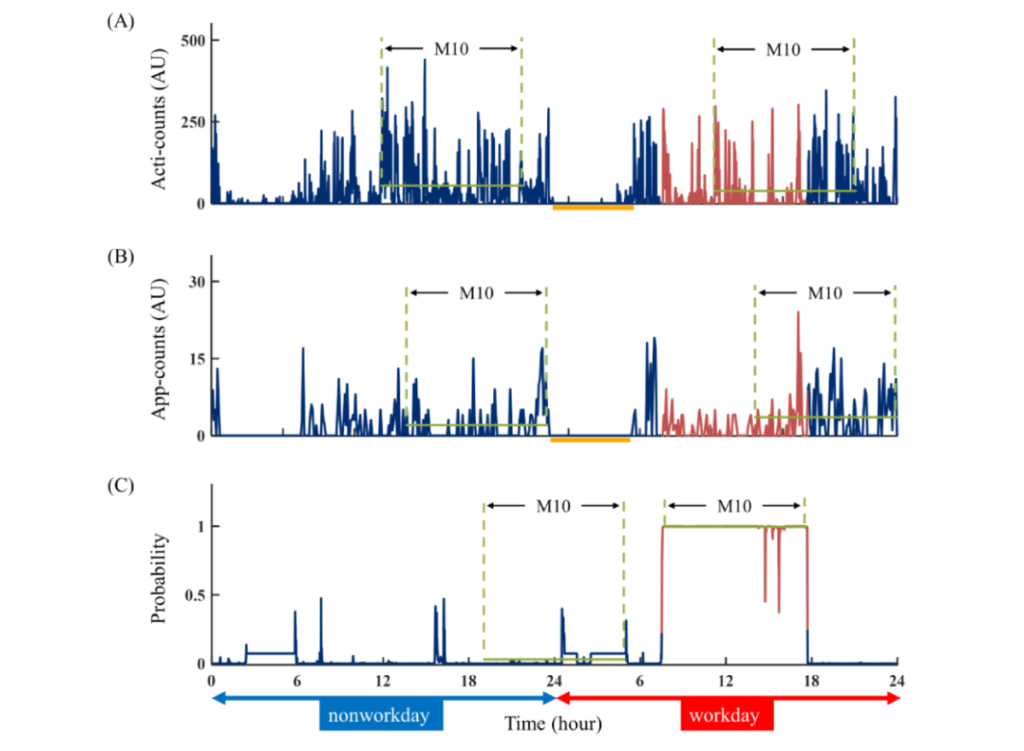Work Hours Tracker
In 2019, we launched the “Staff Hours” app, which automatically records working hours using GPS. Building on our previous research and the development achievements of the Staff Hours app, we are introducing the “Work Hours and Efficiency Tracker” in 2024. This app enables you to accurately calculate your actual daily working hours by automatically analyzing GPS location and smartphone usage behavior, no matter where you are.
Research Foundation
During the COVID pandemic, many people transitioned to remote work, which surfaced the challenge of calculating working hours—distinguishing rests from work at workspaces and work from rest at home. We proposed that workers are in different mental states during work and non-work periods. Based on the stimulus-response principle, users’ reactions—such as response time, intensity, and pattern—to stimuli like smartphone notifications are expected to vary across these states.
Collaborating with Prof Henry Horng-Shing Lu (Institute of Statistics, National Chiao Tung University) and Dr Hung-Hsun Chen (Department of Mathematics, Fu Jen Catholic University), we developed a machine-learning algorithm that combines human-smartphone interaction patterns with GPS-defined work hours to generate probabilities indicating engagement in work-related tasks, which we interpret as “working mental activity (WMA)” to distinguish from “general mental activity (GMA)” represented by app-counts and “physical activity (PA)” by acti-counts. There were significant phase differences between PA, GMA, and WMA, supporting the importance to investigate the rhythms individually (Chen et al., 2024).
When applying WMA to predict probability in work mode, the models’ performances on the testing set, measured by area under the receiver operating characteristic (ROC) curve (AUC), yielded 0.915, indicating an average prediction performance. In the mean time, work hours estimated using the probability in work mode were significantly longer than the GPS-defined counterparts, and the discrepa ncy was attributed to the higher remote work time compared to the break time at work spaces (Chen et al., 2023). By exploring factors that may affect work engagement, we found that late sleep and wake time (i.e. late chronotype), but not total sleep time, was related to reduced working mental activity of the following day (Chen et al., 2024). This application of human-smartphone interaction opened the window for studying work-related behaviors in a more informative while efficient way.
-1024x282.png)

Publish Research
1. Developing Methods for Assessing Mental Activity Using Human-Smartphone Interactions: A Comparative Analysis of Activity Levels and Phase Patterns in General Mental Activities, Working Mental Activities, and Physical Activities.
Chen HH, Lin C, Chang HC, Chang JH, Chuang HH, Lin YH
J Med Internet Res 2024;26:e56144
doi: 10.2196/56144
2. Developing a Machine Learning Algorithm to Predict the Probability of Medical Staff Work Mode Using Human-Smartphone Interaction Patterns: Algorithm Development and Validation Study
Chen HH, Lu HHS, Weng WH, Lin YH
J Med Internet Res 2023;25:e48834
doi: 10.2196/48834
3. Assessing Physicians’ Recall Bias of Work Hours With a Mobile App: Interview and App-Recorded Data Comparison.
Wang HH, Lin YH
J Med Internet Res 2021;23(12):e26763
doi: 10.2196/26763
4. Assessing User Retention of a Mobile App: Survival Analysis.
Lin YH, Chen SY, Lin PH, Tai AS, Pan YC, Hsieh CE, Lin SH
JMIR Mhealth Uhealth 2020;8(11):e16309
doi: 10.2196/16309
5. Automatic Work-Hours Recorder for Medical Staff (Staff Hours): Mobile App Development
Chiang TW, Chen SY, Pan YC, Lin YH
JMIR Mhealth Uhealth 2020;8(2):e16063
doi: 10.2196/16063

